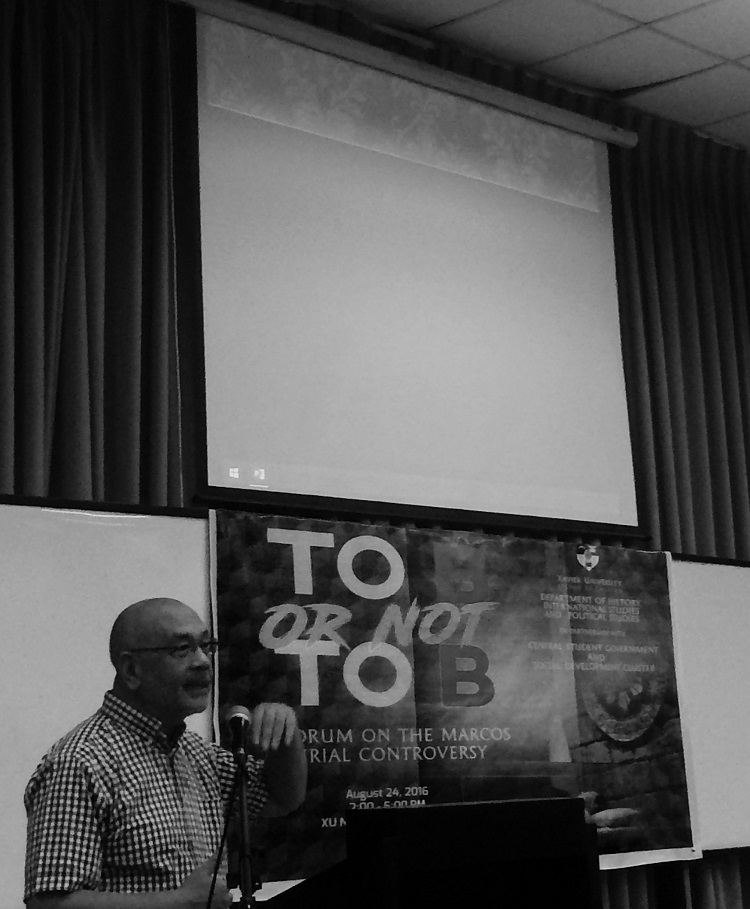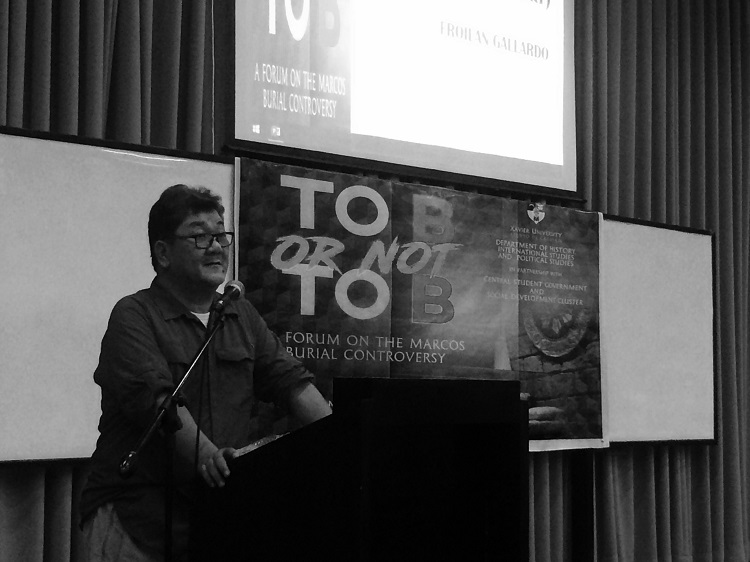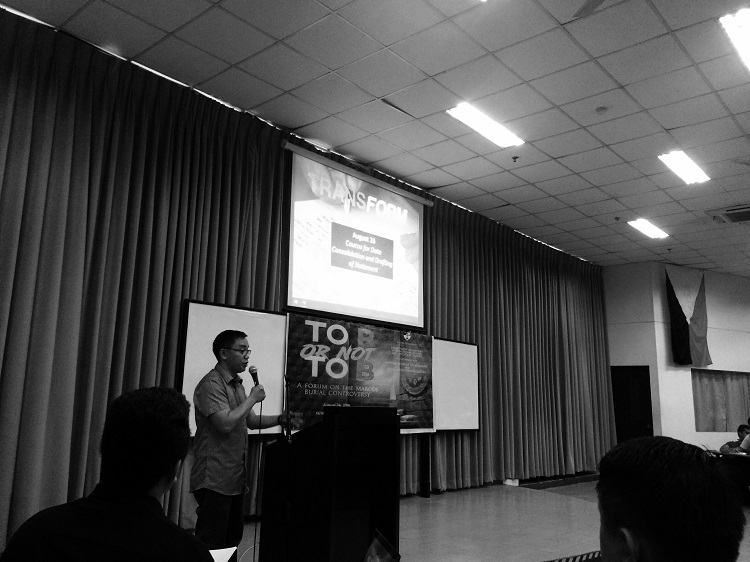 CAGAYAN DE ORO CITY, Philippines — Contrary to popular belief, there is no “eternally embalmed body” of the fallen Philippine dictator Ferdinand Marcos Sr lying in their family's mausoleum in Batac, Ilocos Norte.
CAGAYAN DE ORO CITY, Philippines — Contrary to popular belief, there is no “eternally embalmed body” of the fallen Philippine dictator Ferdinand Marcos Sr lying in their family's mausoleum in Batac, Ilocos Norte.
This is the zenith of the discussion of renowned Filipino historian and anthropologist Dr Antonio Montalvan II during a forum recently at Xavier University - Ateneo de Cagayan dubbed “To B or Not To B,” referring to whether Marcos deserves a hero’s burial at the Libingan ng mga Bayani.
In an en banc decision on Tuesday, August 23, the Supreme Court issued a status quo ante order to all parties involved in the Marcos burial case, prohibiting them from burying him at the Libingan ng mga Bayani for the next 20 days.
“There are many ways to argue if you are pro or against the Marcos burial,” said Montalvan. However, he opted to examine the burial controversy through the lenses of necropolitics, underpinning the tradition of long-term embalming of the late leaders of socialist and dictatorial regimes in different parts of the world.
“There is a script. It’s not just displaying the body, there is a narrative that talks about these people,” he said.
Beyond the public display
In the macabre subject of long-term embalming, Russia had first perfected the craft, setting the preservation of communist revolutionary and political theorist Vladimir Ilyich Ulyanov or Lenin as the successful architype of the process.
“In the Modern Age, we begin with Lenin. Long-term embalming was perfected by Soviet Russia. Lenin was the leader of the Bolsheviks Revolution in October 1917. When he died in 1924, the Soviet government wanted to preserve his body in his mausoleum in Kremlin,” narrated Montalvan. “The temperature inside Lenin’s mausoleum has to be controlled. The embalmers have to apply glycerol, potassium acetate, bleaching reagents, and wax from time to time.”
One major problem the morticians of Lenin faced was the discoloration of his skin, especially on the face and hands. They managed to solve it using a variety of reagents and acetic acid solution in between baths.
Montalvan enumerated other prominent leaders of communist countries who died after Lenin and had been embalmed using the Soviet technique. Their bodies were put on public display inside mausoleums that became tourist attractions over time.
“When Ho Chi Minh of Vietnam died in 1969, the government took the embalmers of Lenin. It has somehow bolstered the tradition perfected by Russia,” he said. Streams of people queue every day just to take a glimpse of Ho's body in a granite mausoleum in Hanoi, modeled after Lenin's tomb in Moscow.
After the death of communist revolutionary and founding father of the People's Republic of China, Chairman Mao Zedong in 1976, the Communist Party of China wanted to preserve his remains and display publicly. However, their government encountered a problem.
“Beijing then was not in friendly terms with its Soviet neighbor, so China turned to Vietnam. It was Vietnam who taught them the long-term embalming process, which the Vietnamese learned from the Soviets,” said Montalvan.
Local and international tourists flock at the Chairman Mao Memorial Hall, more commonly known as the Mausoleum of Mao Zedong, a colossal edifice at the Tiananmen Square, where the Gate of China used to stand.
“My visit to Mao’s mausoleum was uneventful because it was very fast. Before you know, it’s over,” shared Montalvan. Mao’s body, draped in the red flag of the People’s Republic of China, lies in a glass coffin.
“Mao’s crystal coffin is beautiful. It was designed to withstand an 8.0-magnitude earthquake. This is part of the Chinese hubris. Even an 8.0-magnitude earthquake cannot shatter the crystal coffin of Chairman Mao. It has humidity controls also,” said Montalvan. “Every night as soon as the museum closes, his sarcophagus is lowered down to a basement bunker that is refrigerated to preserve the body of this great proletarian, as they call him.”
There is more to displaying Mao’s preserved body to the public, which is part of the narrative of the leader of the Autumn Harvest Uprising in 1927.
“The people just don’t want to see the body of Chairman Mao but the state wants to propagate the idea that Chairman Mao is just there, sleeping. … It’s not just displaying the body, there is a narrative to it,” added Montalvan. Outside Mao’s mausoleum stands the Monument to the People’s Hero and on its front is an inscription in Mao Zedong's handwriting: "Eternal glory to the people's heroes!"
Besides being an expensive process, long-term embalming of departed leaders remains a reality that socialist regimes take seriously. This is also reminiscent in the embalming of North Korea’s Kim Il-sung and Kim Jong-il.
“What do you think is the common thread that you see in this problem about long-term embalming?” asked Montalvan during the forum.
“All of them are leaders of repressive regimes. Their tenures were marked with the curtailment of freedom and human rights. Long-term embalming is not just about idolizing, there is a deeper, underlying reason behind it. They may have been strongmen, but in death, they were just simply dead. They have no control. And so, that is the end of the regime, but it cannot be. The regime has to continue and so there is a need to preserve the body,” he said.
Montalvan added that nowadays should one want to preserve his remains, you just need to keep up with the latest technology in long-term embalming and afford its exorbitant price tag.

DEKADA 70. Veteran photojournalist Froilan Gallardo shares his heartrending experiences during the Martial Law as a young activist in a room packed with students and educators at Xavier University. Supplied photo.
The Marcos conundrum
“To put their bodies on public display is like to literally embody the state. They were made to be larger than life. They may be dead but they are still larger than life. They represent the state that they have founded. There is a narrative behind it so that their legacy will continue for generations,” shared Montalvan.
Keeping the corpse intact is "a way of preserving his regime and legacy," a key segment in what Montalvan described as the "Imeldific script" of Marcos’s narrative.
In 1993, then President Fidel Ramos allowed the repatriation of Marcos’s body. It was flown from a refrigerated crypt in Hawaii, where he succumbed to lupus erythematosus in 1989 while in exile.
In an article published by the Los Angeles Times on November 19, 1991, Bob Drogin described the final days of flamboyant widow Imelda Marcos in Hawaii as “classic, if a bit macabre. She returned to the Philippines in November 1991, after she was acquitted of federal criminal racketeering charges in New York:
Imelda Marcos's final days in Hawaii were classic, if a bit macabre.
She made a surprise farewell visit Saturday to her late husband's shed-like wooden crypt at the Valley of the Temple Memorial Park outside Honolulu, where he has lain since his death in Hawaii in September, 1989.
After aides opened the tomb and then the casket, she spent more than an hour with the corpse. She wept, prayed, dabbed its shiny forehead, held its stiff hand, ran her fingers through its black wig, and whispered in its waxen ear. She twice called photographers up the wooden platform to record the ghoulish scene.
“In other words, Imelda was not just preserving the body of Marcos, she has a script. We have to understand it that way that she has a narrative behind this. She wants to present Marcos as still larger than life, not just somebody six feet below the ground,” said Montalvan.
Montalvan wrote in his column on Philippine Daily Inquirer (15 August 2016) titled “There is no refrigerated crypt”: "With all their flaunted ill-gotten wealth, it will take millions of low-value peso to maintain the long-term embalming of Marcos’ remains. One sees none of the features in the Mao mausoleum inside the Marcos tomb. And the glass coffin is anything but special — it is just a rectangular glass case that one can readily order in the glass shops in Quiapo. And there is no hydraulic lift to lower and raise that coffin to a refrigerated crypt in a basement mortuary.”
The historian had the opportunity to visit the Marcos mausoleum twice. “My first time was in August 2000, 16 years ago. My second visit was very eventful because I was with the group of museum professionals. We were there to celebrate the National Museum Day and to visit the Museo de Iloko. Irene Marcos-Araneta joined us from Manila to Laoag.”
During his second visit to the mausoleum, a close Marcos family friend whom Montalvan did not name intimated a secret to their group.
“He said, ‘That’s not the body anymore. That’s just a wax replica.’ The real body has already been buried. Where? Underneath the glass coffin.”
Montalvan iterated, “Marcos still lies here.” However, should the controversial former Philippine president be given a hero’s burial at the Libingan ng mga Bayani, his throbbing question is: "What do we bury?" ∎

TAKE A STAND. Nestor Banuag, advocacy coordinator of XU Social Development Cluster, encourages the participants of the forum to reflect and discern on the Marcos burial controversy before taking a stand. Supplied photo.
"To B or Not To B: A Forum on the Marcos Burial Controversy" was organized by the XU Department of History, International Studies and Political Science, in partnership with the Social Development Cluster and Central Student Government, held at the Nursing Amphitheater as part of the History Month celebration.